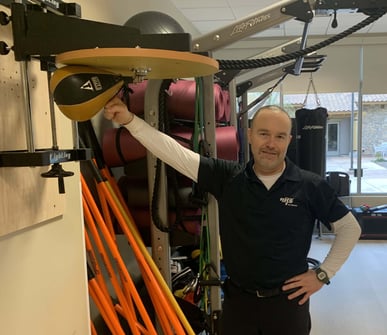 Training elements from boxing have become very popular in the active aging segment of the population so it stands to reason that it would be a great training element to include in a senior living fitness program. The benefits when done correctly are immense and include improved balance, cardiovascular fitness, strength, agility as well as hand-eye coordination which translate very well to the functional demands of advancing age. Training methods should concentrate on balance, safety, (lots of water breaks and watch for overexertion,) and most of all….fun! Incorporating boxing into existing group fitness classes or implementing a low impact cardio kickboxing class is a great way to jazz up your group fitness calendar for residents and it is particularly beneficial for residents with Parkinson’s Disease.
Training elements from boxing have become very popular in the active aging segment of the population so it stands to reason that it would be a great training element to include in a senior living fitness program. The benefits when done correctly are immense and include improved balance, cardiovascular fitness, strength, agility as well as hand-eye coordination which translate very well to the functional demands of advancing age. Training methods should concentrate on balance, safety, (lots of water breaks and watch for overexertion,) and most of all….fun! Incorporating boxing into existing group fitness classes or implementing a low impact cardio kickboxing class is a great way to jazz up your group fitness calendar for residents and it is particularly beneficial for residents with Parkinson’s Disease.
Boxing teaches a can-do spirit and instills a level of resiliency that can help those facing difficult tasks, including coming back from injury or sickness. Even though the sport of boxing is an individual one, the camaraderie and community associated with the training is ideal for building social ties and the sense of accomplishing something difficult as a group. The saying that “it’s not how many times you get knocked down but how often you get up!” is universally understood and applicable to almost everyone. Not sure how to get started? Check out the suggested progression below!
- Shadowboxing in the mirror is the best way to begin a workout as it encompasses all the techniques involved in boxing training and gives one instant feedback on how they are progressing. Teaching certain combinations like jab, cross, hook and so forth will also engage the memory and will be entertaining to the class or individual as they try to follow along. Shadowboxing is also great to do first as it is a nice low-impact workout. 30 seconds on with a 30 second break then repeat.
- Next, work on a strength element like static squats and wall push-ups to allow for a recovery of the cardiovascular system. 30 seconds for the static squat/ 30 second break and 30 seconds of wall push-ups followed by a 30 second break.
- Hand/Eye coordination is next and can be done on a speedbag, double-end bag or even playing catch with a pickleball. 30 seconds on, 30 second break.
- After that, working with a heavy bag will develop strength and balance. Hand wraps and appropriate gloves should always be used with this type of work. Those looking for a softer impact can barely ‘tap’ the bag and focus more on the cardio/balance aspects. 30 seconds on, 30 seconds break.
- Mitt work is probably the most fun part of the class or training session and a chance for the boxers to show their stuff. Form a circle or line and have the boxers step in and out for 3 to 5 punch combinations. Make sure everyone has gloves on for this exercise or they can shadowbox in your direction, and you can pretend to be an opponent while keeping safe distance.
Variations of this circuit can be repeated and or modified to allow for different abilities. Finish with 5 minutes of stretching and plenty of water. Have fun and go get ‘em champ!
Considering whether there is opportunity to kick your group fitness calendar up a notch to reach more residents? Read more here…

